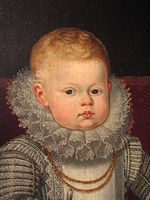Infante Alonso of Spain
| Infante Alonso of Spain | |
|---|---|
 Detail of the portrait of the infante and his brothers Ferdinand and Margaret by Bartolomé González in the Kunsthistorisches Museum, Vienna | |
| Born | (1611-09-22)22 September 1611 Madrid |
| Died | (1612-09-16)16 September 1612 (aged 11 months 25 days) Madrid |
| Burial | Panteon de Infantes, El Escorial |
| Father | Philip III of Spain |
| Mother | Margaret of Austria |
Alonso of Spain (22 September 1611 – 16 September 1612) was an infante of Spain, who died in childhood.[1]
Life
He was born in the Monastery of El Escorial, from the marriage of Philip III of Spain and Margaret of Austria.[2][3][4][5]
He was the last of the couple’s eight children and the fourth male. His mother died as a consequence of his birth a few days later. This circumstance earned him the nickname of El Caro (the Dear), for which he was known in his short life as Don Alonso el Caro.
He was baptized in his birthplace where he was born, on the 8th October of that same year on the feast of Saint Francis of Assisi. The baptism was not public and festive, due to the recent death of his mother.[6] His godparents at baptism were his older siblings Anne and Philip, the sacrament being administered by the Patriarch of the West Indies, Diego de Guzmán.[7] He was carried to the baptismal font by his cousin Philip Emmanuel of Savoy, Prince of Piedmont.[Note 1][8]
The choice of the name Alonso, or Alfonso, was related to the memory of the ancient kings of Castile.[5]
He died before he was one year old and was taken to the monastery of San Lorenzo de El Escorial.[3][9][10] His tomb is located in the sixth chamber of the Panteón of Infantes, commonly known as the nursery mausoleum, under the inscription:[11]
ALPHONSVS, PHILIPPI III FILIVS
As happened one year before with the death of his wife Margaret,[5] Philip accepted his son’s death with resignation.
Notes
- ^ In Spanish royal baptisms, the honour of bringing the newborn to the baptismal font was second in importance only to the one of being godparent.
References
- ^ Robles do Campo, Carlos (2005). "Los infantes de España en los siglos XVI y XVII" (PDF). Anales de la Real Academia Matritense de Heráldica y Genealogía. 9: 383–414. ISSN 1133-1240.
- ^ Cabrera de Córdoba, Luis (1857). Relaciones de las cosas sucedidas en la corte de España, desde 1599 hasta 1614 (in Spanish). Madrid: Imprenta de J. Martín Alegria. p. 448.
- ^ a b Conde Mora, Francisco Glicerio. "Alonso de Austria". Diccionario Biográfico Español.
- ^ Mariana, Juan de (1839). Historia general de España, 9: ultima edición anmentada con las tallas del autor y la continuación de miñana traducida, que llega hasta el año 1600 y adicionada unicamente en esta edición con una narración de sucesos desde 1600 hasta 1833, o sea hasta la muerte del rey Don Fernando VII (in Spanish). Francisco Oliva. p. 20.
- ^ a b c Gonzalez de Avila, Gil; Salazar de Mendoza, Pedro (1771). Historia de la vida y hechos del inclito monarca, amado y santo D. Felipe Tercero. Obra posthuma (etc.): 3 (in Spanish). Vol. 3. Madrid: Ibarra. p. 158.
- ^ Cabrera de Córdoba, Luis (1857). Relaciones de las cosas sucedidas en la corte de España, desde 1599 hasta 1614 (in Spanish). Madrid: Imprenta de J. Martín Alegria. p. 452.
- ^ Flórez, Enrique (1770). MEMORIAS DE LAS REYNAS CATHOLICAS,: STORIA GENEALOGICA DE LA CASA REAL DE CASTILLA, Y DE LEON, TODOS LOS INFANTES: TRAGES DE LAS REYNAS en Estampas: y nuevo aspecto de la Historia de España. TOMO II (in Spanish). Madrid: En la oficina de la viuda de Marin. p. 929.
- ^ Rodríguez Moya, Inmaculada (2018). "El bautismo regio en la corte hispánica: arte y ritual del siglo XVI al XVII". Archivo español de arte. 91 (364): 349–366. doi:10.3989/aearte.2018.21. hdl:10234/179904. ISSN 0004-0428 – via Dialnet.
- ^ Cobo Delgado, Gemma (2013). "Retratos infantiles en el reinado de Felipe III y Margarita de Austria: entre el afecto y la política". Anuario del Departamento de Historia y Teoría del Arte. 25 (25): 23–42. doi:10.15366/anuario2013.25.002. ISSN 1130-5517 – via Dialnet.
- ^ Gascón de Torquemada, Gerónimo (1991). Gaçeta y nuevas de la Corte de España desde el año 1600 en adelante (in Spanish). Madrid: Real Academia Matritense de Heráldica y Genealogía. p. 31. ISBN 978-84-600-7855-5.
- ^ Rodríguez Díez, José (2014). "Epitafios del Panteón de Infantes del Monasterio del Escorial y sus fuentes bíblicas". El mundo de los difuntos: Culto, cofradías y tradiciones.2. 2. Ediciones Escurialenses: 825–856. ISBN 978-84-15659-24-2 – via Dialnet.
- v
- t
- e
- Felipe IV
- Infante Carlos
- Infante Fernando
- Infante Alonso
- None
- None
- Luis I
- Infante Felipe Pedro
- Fernando VI
- Carlos III
- Felipe I, Duke of Parma
- Infante Luis, Count of Chinchón
- None
- 1 title granted by Royal Decree
- 2 consort to an Infanta naturalized as a Spanish Infante










